The ThorFire TD26 flashlight is a 100 meter diving light that operates on a single 26650 or 18650 battery powering a Cree XP-L emitter. It is sold as a kit with an 18650 cell and charger.
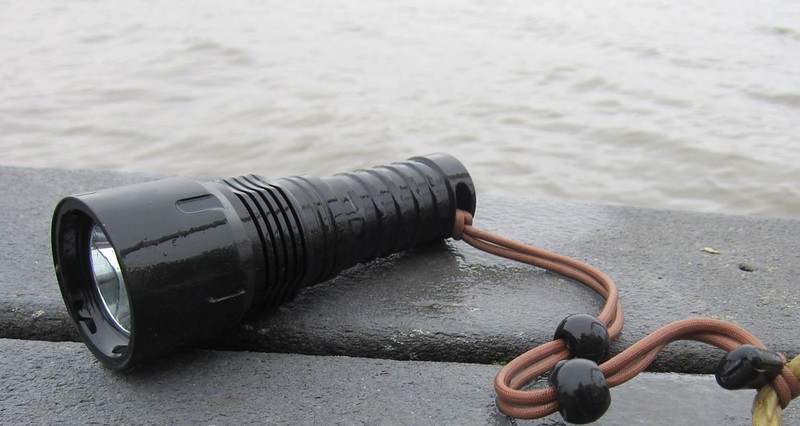
Here are the key review details:
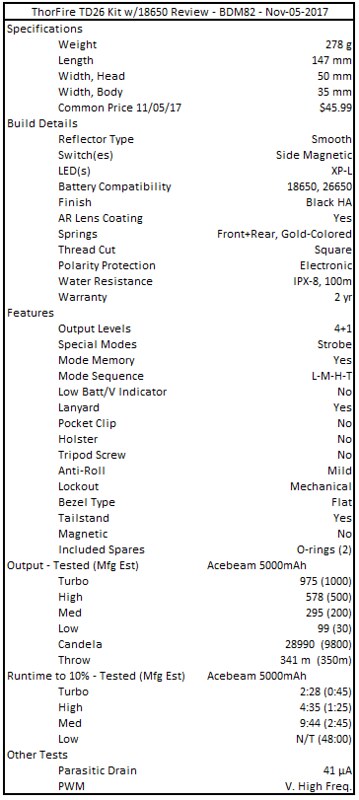
Skip to the commentary section at bottom to read my subjective notes on the TD26.
Disclaimer: This light was provided free of charge by ThorFire, shipping through the closest Amazon distribution center. As of November 5, 2017, the light can be purchased through Amazon (U.S.) for $45.99.
Unboxing
ThorFire uses the same packaging throughout most of their product line: A simple but sturdy cardboard box with white label. The TD26's label shows the TD26 light and included accessories. IT also lists the ThorFire website and contact information.
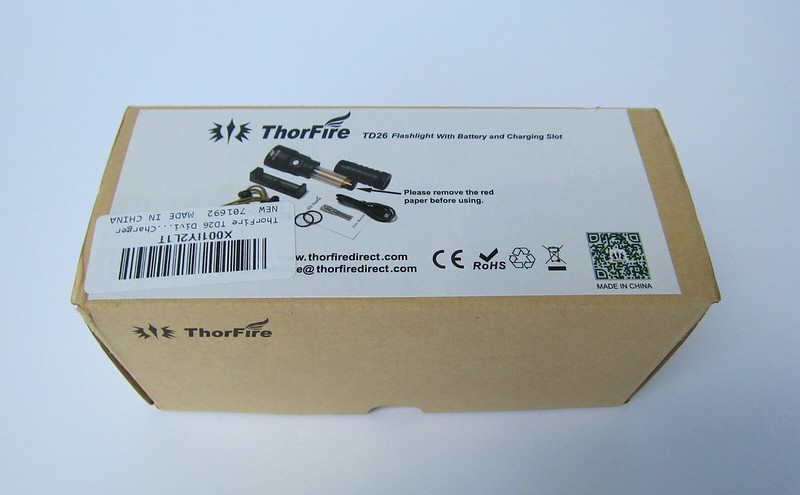
The TD26 is protected by bubble wrap and a sandwich of foam on top and bottom.
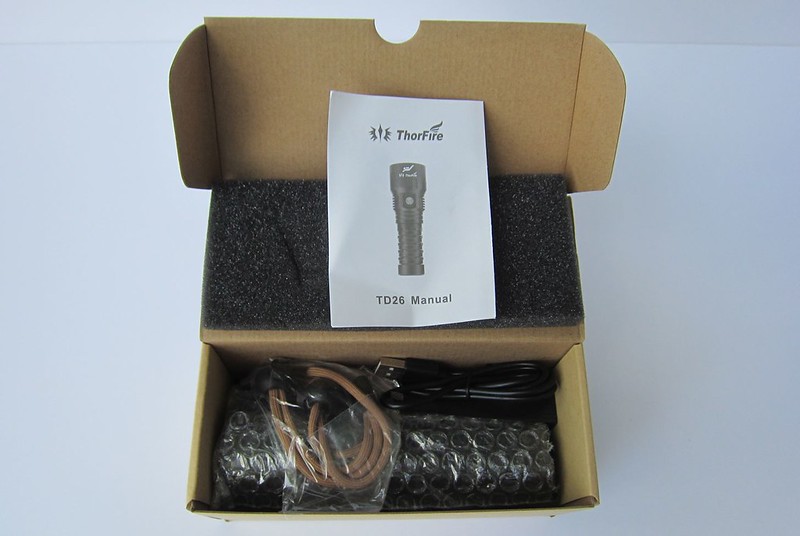
Spare o-rings, lanyard, manual, charger, and battery (inside the light) are included.
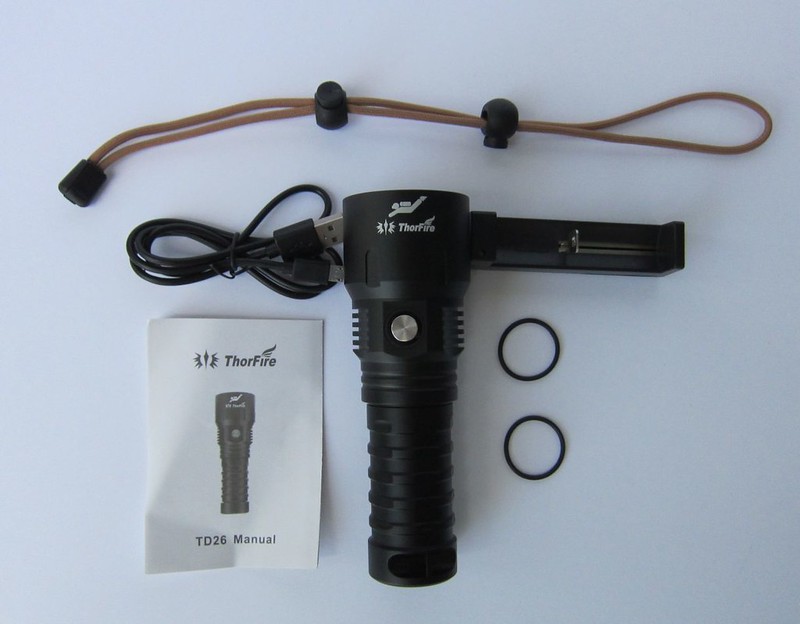
The included manual is in English only. It properly covers modes, features, operation, and troubleshooting.
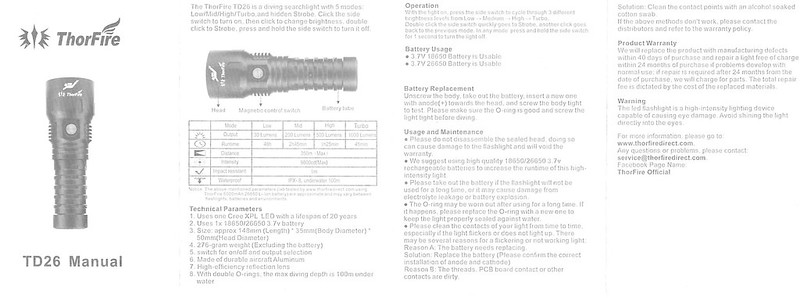
ThorFire backs the TD26 with a 2 year warranty. Repair after 24 months is available for the cost of shipping and parts.
Design
The TD26 is a solidly built 26650-based light as required for its intended purpose: scuba diving. The light weighed 278 grams without battery– significantly more than other (non-dive-rated) single cell 26650 lights like the Olight R50 (158 g) or Acebeam EC60 (128 g). All parts of the TD26 are built thicker and stronger so it can survive water pressure at depths up to 100 m.
ThorFire's specifications report the TD26 to have 148 mm length, 50 mm width at head, and 35 mm width at the battery tube. My measurements were +/- 1 mm of those specs.
The size of TD26 is apparent when compared with other 26650 lights.
Left to Right: ThorFire S70S (2*26650), Utorch UT02, ThorFire TD26, Acebeam EC60, Olight R50 Pro.
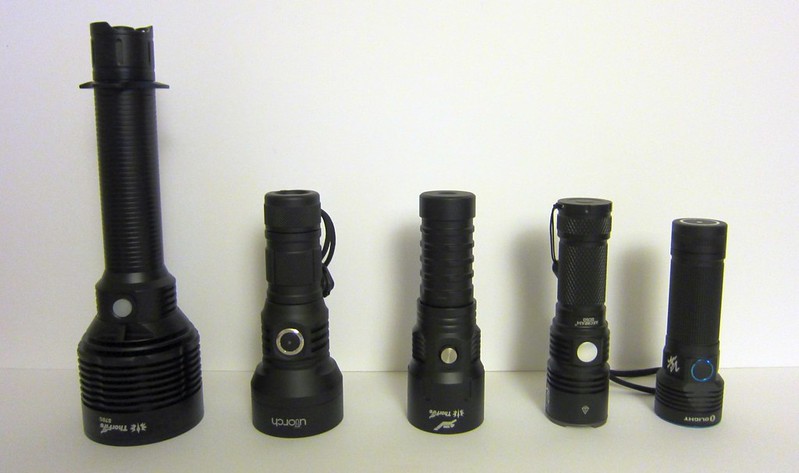
Another comparison picture,
Left to Right: Olight M3XS-UT (18650*2), Utorch UT02 (26650), ThorFire TD26 (26650), Acebeam EC60 (26650), Olight R50 Pro (26650), Nitecore P16 TAC (18650), ThorFire TK15S (18650).
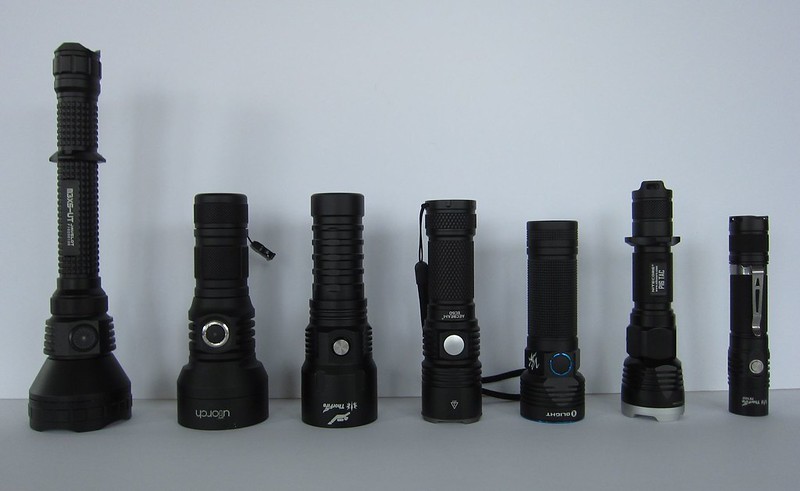
The TD26 with other ThorFire lights,
Left to Right: S70S (2*26650), TD26 (26650), TK15S (18650), TK15 (18650), VG-15S (18650), TG06S (AA).

Finally, here's the TD26 in hand. The wetsuit gloves are 3mm neoprene, size large.
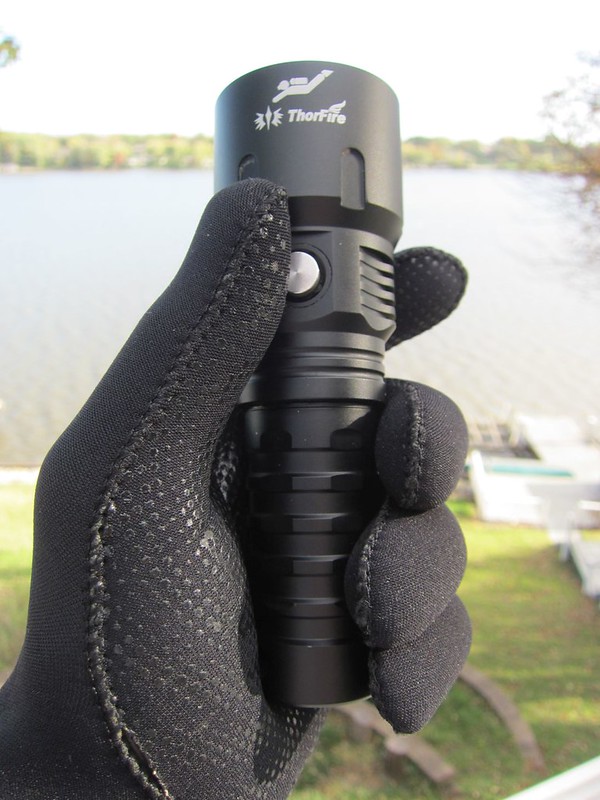
The head of light has a thick, flat bezel and recessed lens. The depth helps protect the lens from damage. I did not attempt to remove the lens retaining ring but a thick gasket is visible between the lens and reflector.
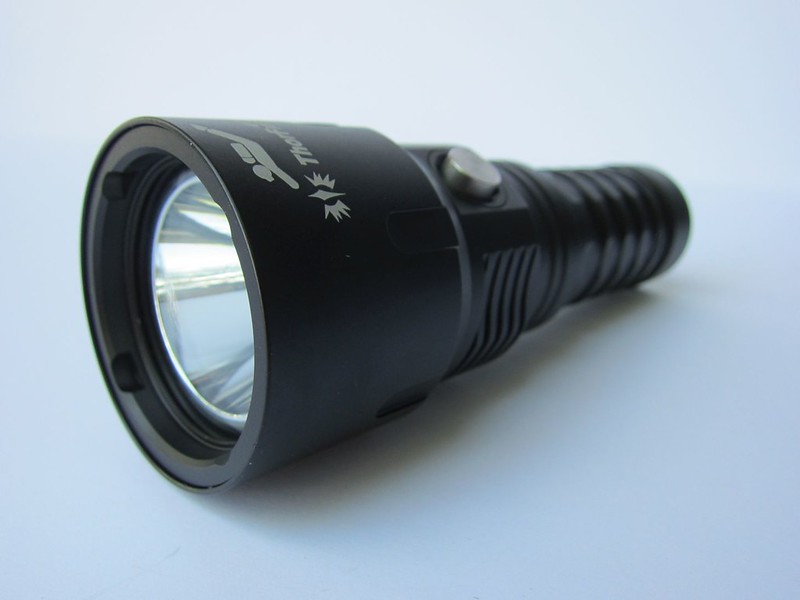
The reflector is smooth and nearly imperfection-free; I found one small imperfection caused by dust but otherwise is clean and nice. The glass is AR-coated.
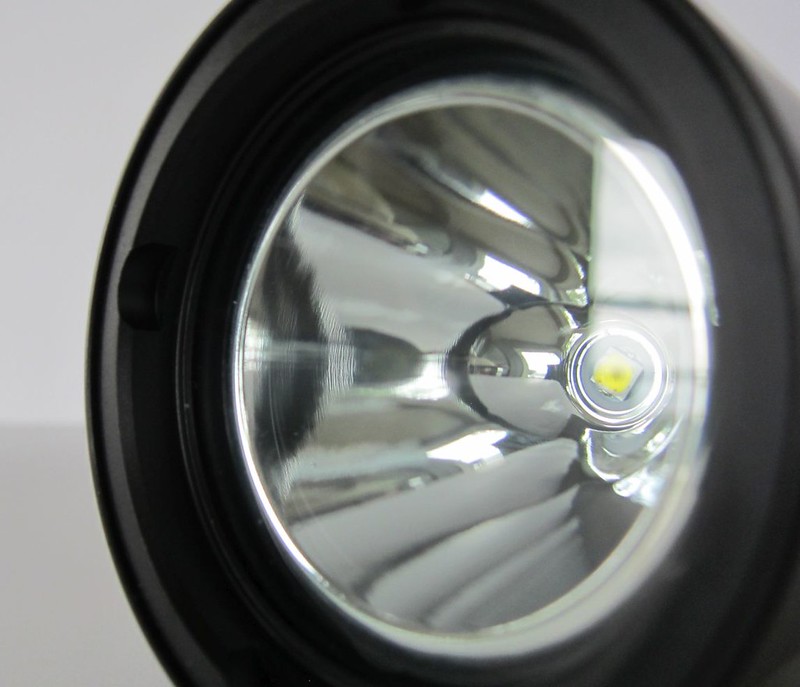
The XP-L emitter is perfectly centered. A small amount of excess solder is visible around the LED.

The head of the TD26 has the ThorFire logo and a scuba diver embossed in white. This is the only writing on the entire light. Edges are crisp and the printing has stood up well through my month of testing the light.
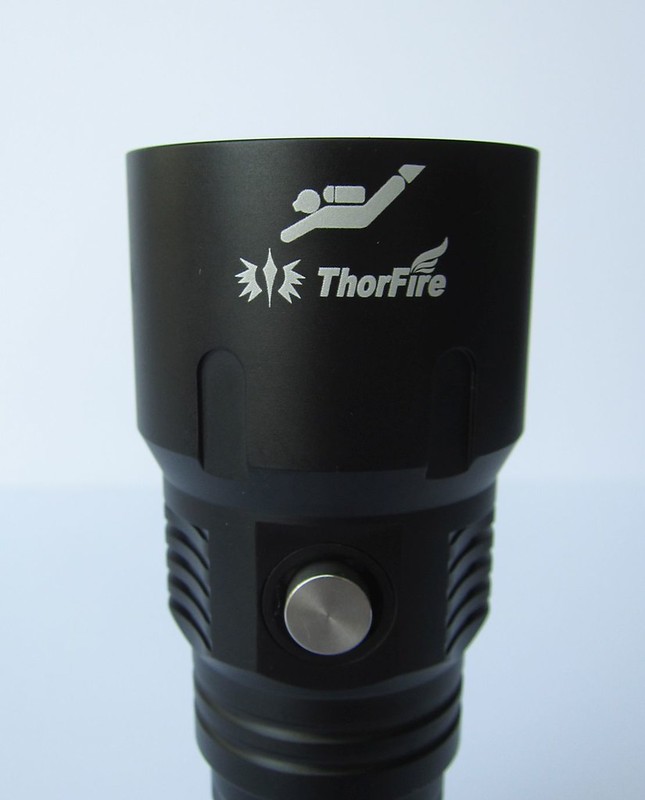
The side switch is a bare metal circle, raised and easy to locate by hand. Being a magnetic switch (common for dive lights), the feel is a bit artificial with no click or indent when pressed. There is also no rubber boot around the switch, so water can also get behind the switch button. This causes water to squirt out of the switch for a while after the light is out of the water (though to no detrimental effect).
The other thing I've noticed about the switch is that occasionally a very fast button press isn't registered. It takes a little bit of practice to get the feel for the timing since too short does nothing and too long turns the TD26 off.

The notches between the switch and the bezel provide a mild roll resistance.
Anodization is consistent and free of defects. It survived several drops indoors – and 2 days underwater – without any damage.
Rather than knurling, the light has raised ridges down the body tube of the light. These have alternating round and flat spots – and provides excellent gip. At the tail, these transition to a sizeable lanyard hole.
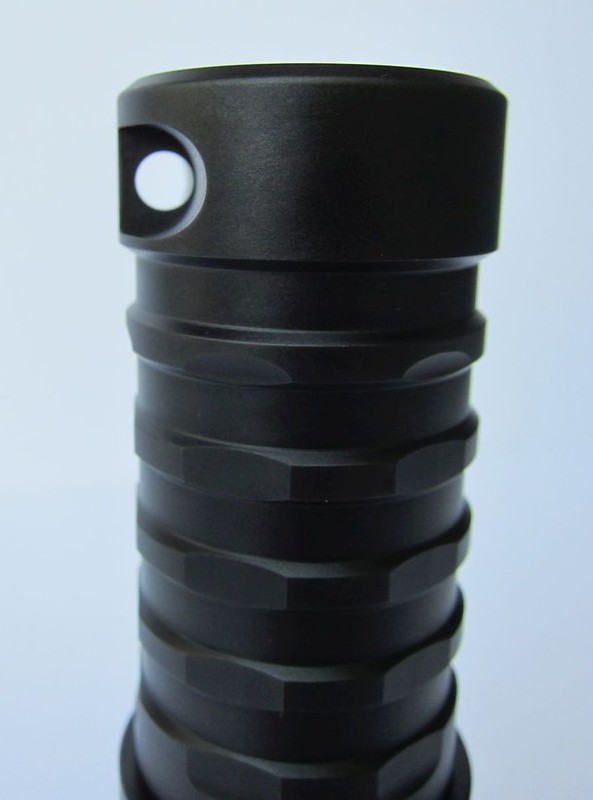
The included lanyard is thick – and a toothpick or other aid is required to feed the lanyard through the hole. As it attaches on the side, tailstanding is unaffected.

The lanyard itself has two spring-tensioned clips for cinching the lanyard on a wrist. Redundancy is key when diving; I'm glad to see ThorFire included two. The lanyard is also brown. At first, I thought this was a strange choice as most lanyards are black. But after using the TD26 in a freshwater lake, I think it was a very wise move by ThorFire. The lanyard looks the same after being in the dirty lake as it did before going in.
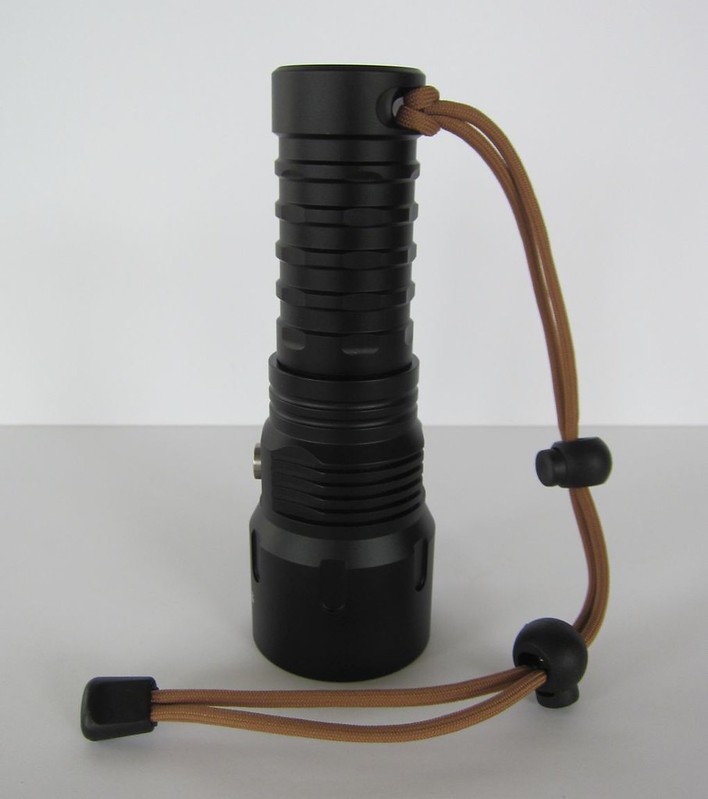
The TD26 disassembles into 2 sections – head and body tube. There is no separate tail cap. As expected for a dive light, the TD26 has two o-rings to prevent water ingression. ThorFire rates it to 100 meters underwater, IPX-8.
Threads are square cut and very well lubricated. They are also anodized, so a quarter turn of the tail will mechanically lock out the TD26.
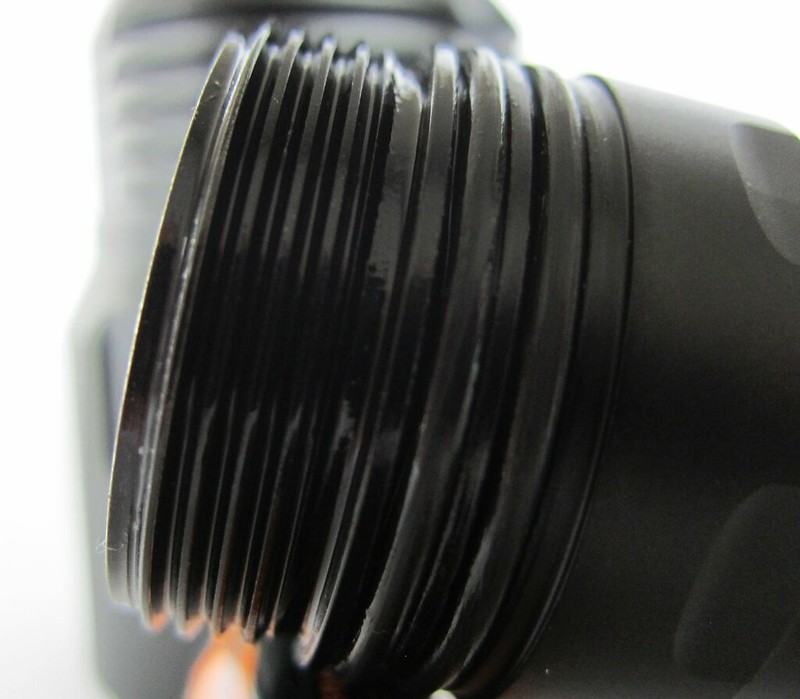
The tail cap has a wide gold-colored spring.

The head has a smaller gold-colored spring, so both button top and flat top cells will work. Electronic reverse polarity protection and low-voltage shut-off means that unprotected cells can safely be used. Also notice how thick the wall of the head is!
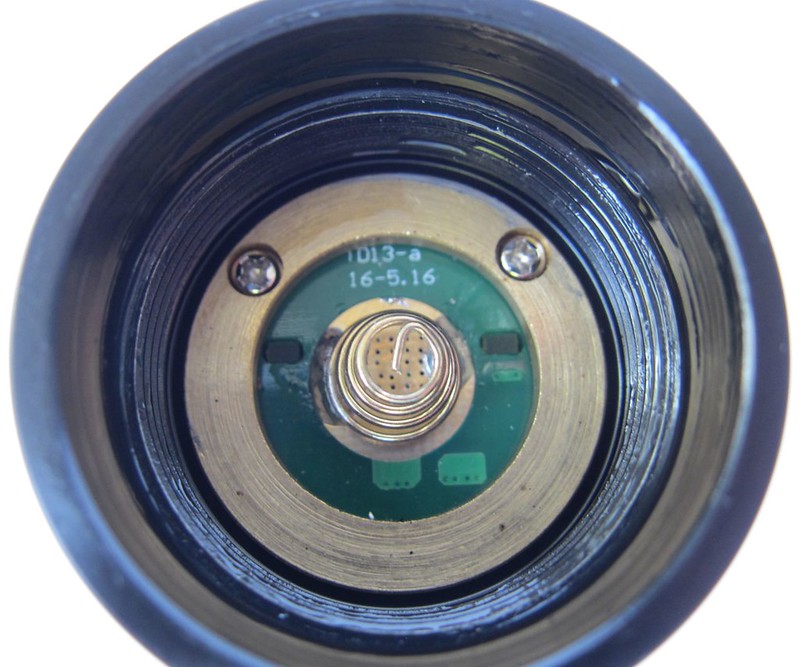
The light includes a battery spacer so that narrower 18650 cells can be used in the 26650-width body. The inner diameter of the spacer is a couple mm too wide, so the cell can rattle a bit (though not affecting performance).
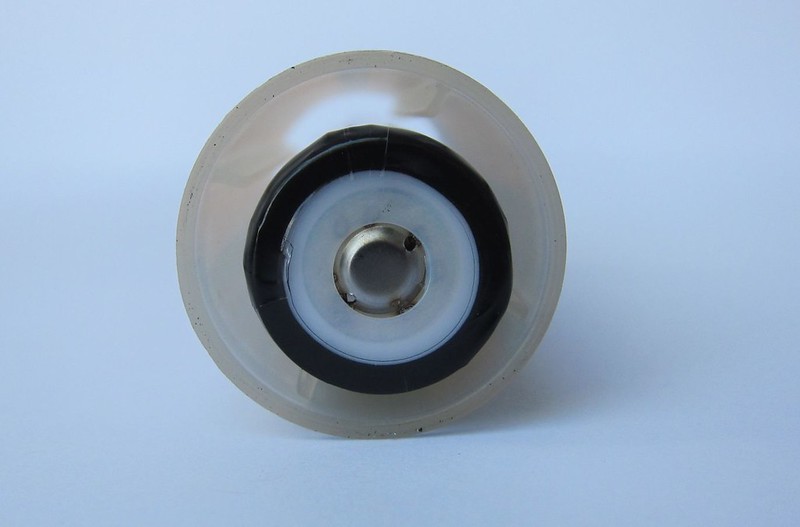
Performance
Beam
The smooth reflector produces a defined hotspot and corona with a weaker but still useful spill.
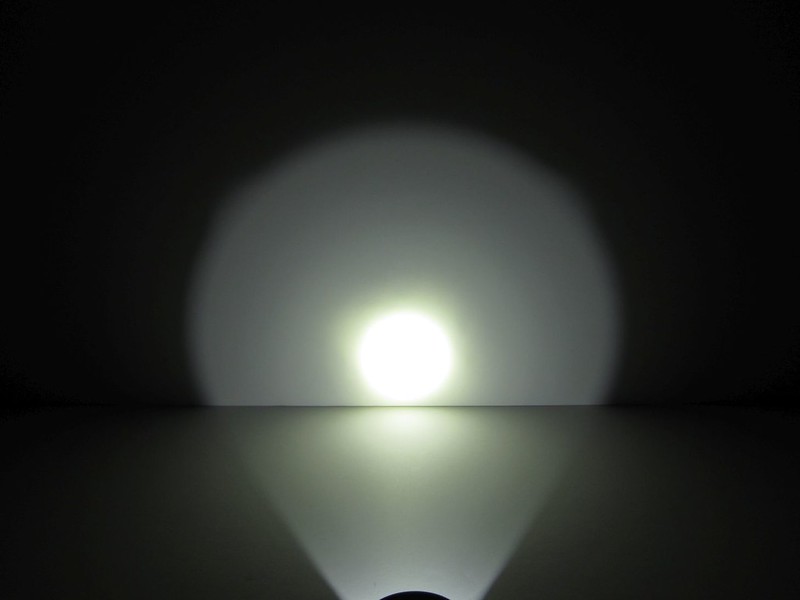
Tint
The bin is not specified by ThorFire, but I found the XP-L's tint to be very agreeable. The hotspot is neutral white, the corona is ever-so-slightly yellow, and the spill has a hint of cooler blue. Approximate temperatures were 4800K in the hotspot, 4300K in the corona, and 5700K in the spill.
To demonstrate the overall color balance, here is the TD26 surrounded by lights with emitters of various tints and temperatures.
L to R: Jetbeam C8R with cool XM-L2 T6, Convoy S2+ with cool XM-L U2 1B, ThorFire TD26 with XP-L, Astrolux S41S with neutral 219B, Lumintop Tool with warm 219B.

Output
ThorFire rates the TD26 at 1000 lumens on Turbo. 18650 or 26650 batteries can be used, but CR123As are not compatible per the manual.
The TD26 kit includes ThorFire's own 3000mAh BRC18650 cell. When I tested the cell in the TD26, it registered a disappointing 758 lumens on Turbo – well short of the 1000 expected. However, further tests identified the problem – and solution.
The included ThorFire 3000mAh 18650 had a three-test average internal resistance of 207mOhm using an Opus 3100 charger. For a brand-new cell, this is high. (It should be noted that the capacity did test north of 3000mAh, so the capacity rating is honest though the resistance is high.)
I then switched to an Acebeam ARC26650NP 5000mAh protected 26650 cell. Turbo output at 30 seconds registered a much higher 975 lumens – right in line with ThorFire's specifications. The 1000 lumen rating is accurate.
Since the Acebeam battery performed so much better, I then tested an unprotected Efest 4200mAh cell expecting to get even higher results. However, it generated only 887 lumens – quite strange.
Doing some more testing, I confirmed the reason – the protected cell's added length compressed the springs more, creating a shorter path for the current and thus higher output. Adding a small neodymium magnet to the Efest cell (to extend the length) added over 100 lumens!
Unfortunately, the ThorFire cell only saw a bump of less than 20 lumens on Turbo.
What's the takeaway? Skip the included ThorFire cell and use the longest high-drain cell you have for the best performance!
Back to the output tests… Using the Acebeam battery with ambient temperature of 78 degrees Fahrenheit, output was 989 lumens at turn-on and 975 lumens at 30 seconds.
Output was then a gentle curve down to 450 lumens at 2 hours and 28 minutes – when the light powered off. ThorFire reports a 45 minute runtime using a 5000mAh cell; this is significantly understated.
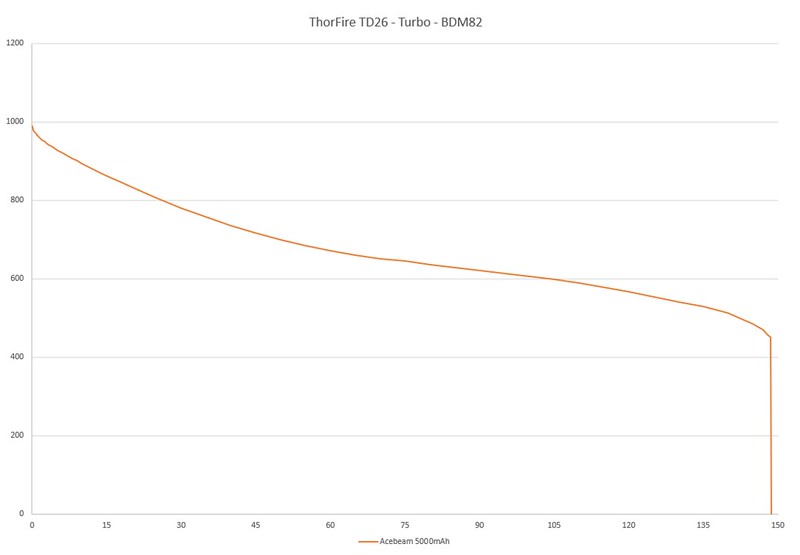
The TD26 dissipated heat very well. The light's external temperature didn't exceed 97F. As water dissipates heat better than air, heat should not be a concern with the TD26.
High is rated by ThorFire at 500 lumens. I measured 587 lumens at turn on and 578 at 30 seconds using the aforementioned Acebeam battery. Output dropped to 229 lumens at 4 hours and 35 minutes at which point the TD26 powered off. This 4:35 runtime exceeds ThorFire's 1:25 rating dramatically.

Medium is rated at 200 lumens. I measured it a bit higher at 295 lumens. Output once again dropped in a gentle curve, down to 97 lumens at 9 hours and 44 minutes when the TD26 powered off. ThorFire's 2:45 rating is 7 hours short of the light as tested!

Low is rated at 30 lumens per the manual but 100 lumens per the Amazon listing. I measured 99 lumens. Runtime was not tested.
While very low modes are not useful underwater in most situations, a lower mode would add versatility to the light when used on land. 99 lumens is quite high for the lowest mode.
All outputs as tested with various batteries:
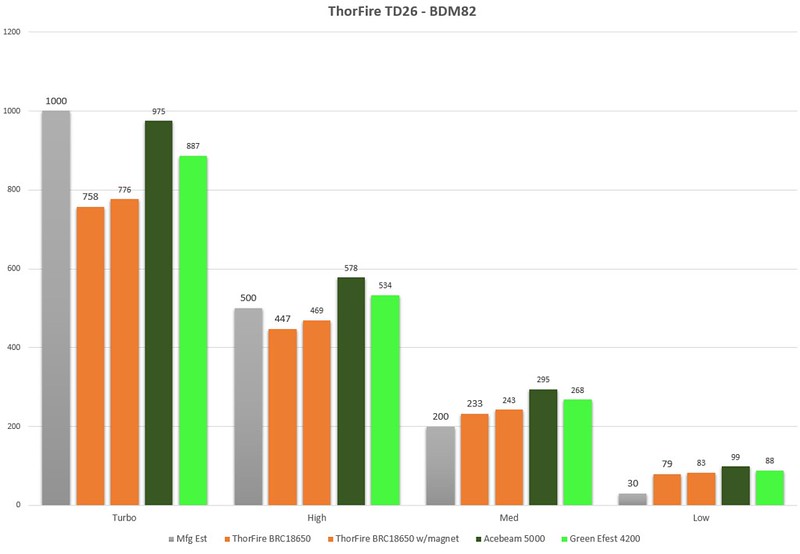
All runtimes tested:
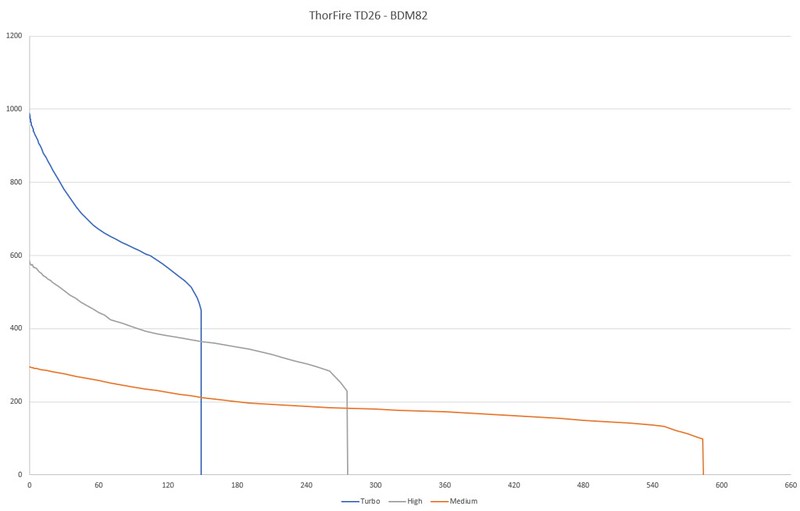
Water Resistance Tests
Since the TD26 is built for diving, I thought it prudent to run it through some stress tests.
First, I tied it to a rope, turned it on Medium, and threw it about 30 feet out into the water off my dock. The water depth is only around 2.5m – far short of the 100m the light is rated for, but I left it out there for over 48 hours.

After pulling it in, the TD26 worked without issue and was completely dry inside, as it should have been. Some mud caked into the cooling fins and anti-roll indentations reflect the time it spent on the bottom of the lake.
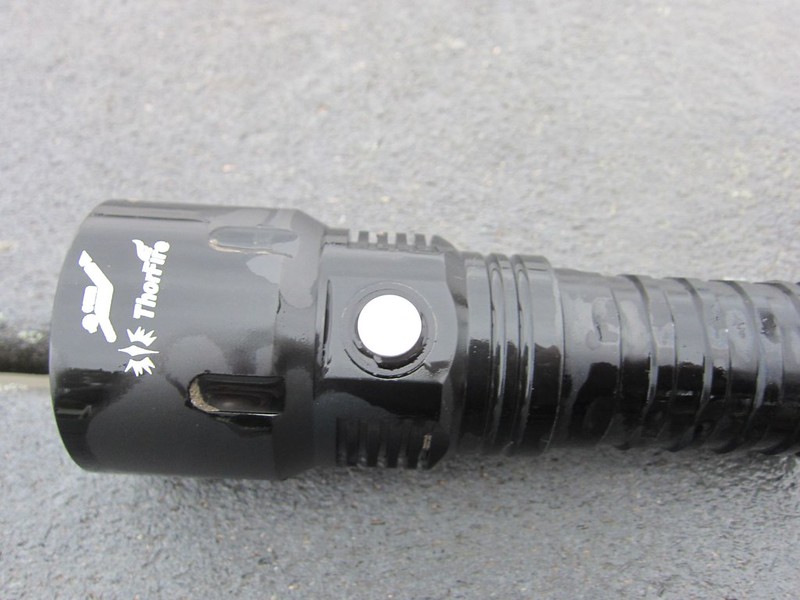
The second water resistance test is commonly called the "freezer test." First, the light is placed in a freezer (disassembled) until it reaches 0F (-17.7C). Then the light is assembled and quickly dropped into a bowl of hot water. As the temperature of the cold air inside the light rises, it builds pressure and tries to escape.
The TD26 also passed this test. None of the pressurized air escaped past the o-rings and out of the light. (The small bubbles are from the water, not the light. Notice no bubbles where the battery tube and head connect – the vulnerable point.)
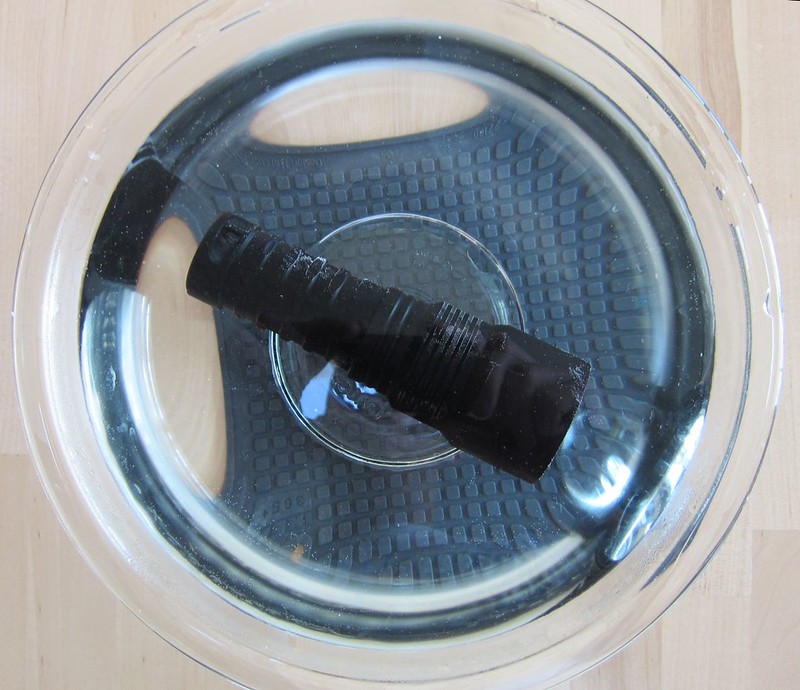
Amperage Draw
As measured:
Throw
With the included ThorFire battery, I tested throw distance at 1.46 meters and the resulting candela was 21,082 at 30 seconds - equivalent to 290 meters of throw. The Acebeam battery produced 28,990 Cd, good for 341 meters of throw.
ThorFire rates the TD26 at 350 meters of throw – which seems to be an honest rating. However, the manual lists Cd at 9800 – which would only be 198m of throw. 9800Cd appears to be a misprint.
PWM
Very high frequency PWM appears to be present on all modes. I was unable to see it visually in normal use or using the "mirror test." A camera's CMOS sensor did show the typical signs of high frequency PWM, though.
Parasitic Drain
The TD26 uses an electronic switch so some parasitic drain is normal. Only mechancial switches (which fully break the electrical circuit) escape having some parasitic drain. Dive lights generally use electronic (magnetic) switches so that one more point of ingress for water is eliminated.
The TD26 had a very low parasitic drain of only 41 μA. Using a 5000mAh 26650 cell, it would theoretically take almost 14 years to drain the cell. Thus, parasitic drain is of no concern with the TD26.
Mechanical lock out (thus breaking the circuit and reducing parasitic drain to 0) is possible by simply unscrewing the body tube a quarter turn.
Low Voltage Battery Protection
The battery's own low-voltage protection was not tripped on any tests. In fact, the TD26 has an abnormally high cut-off voltage between 3.3 and 3.4V. Runtimes would be longer (while still protecting the battery) if cut-off voltage was in the more common 2.8-3.0V range.
Included Charger
The included single cell ThorFire charger is designed to charge lithium-ion cells. It uses 1A, 5V micro-USB input to generate a max charge rate of 0.75A at 4.2V, per specifications. Connected to an inline USB meter, it detected power consumption of 0.76-0.83A – which is in line with ThorFire's specifications.
When no cell is present, or charging is complete, the single LED indicator on the charger is green.
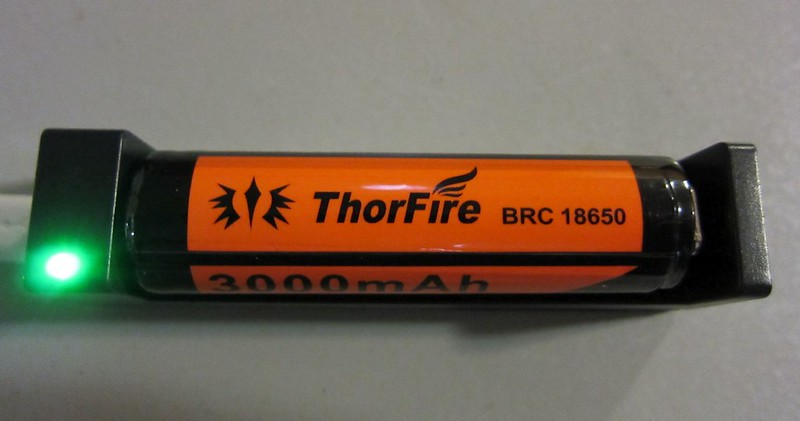
When charging is in progress, the LED indicator is red.
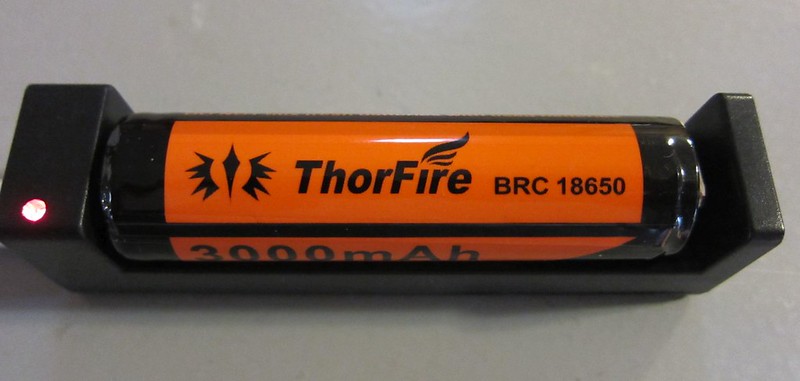
Outdoor Beamshots
All photos taken with a Canon SD4000IS camera. 1/10" exposure, ISO1600, Daylight white balance, F2.0.
Approximate distances: White deck railing @ 15 ft., white fence in distance @ 75 ft., center of boat @ 100 ft.
Control shot:
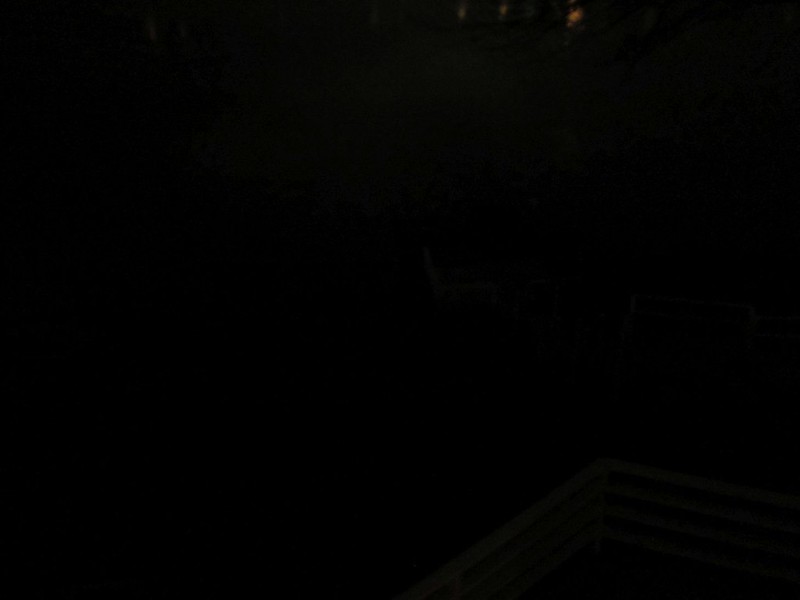
Low:
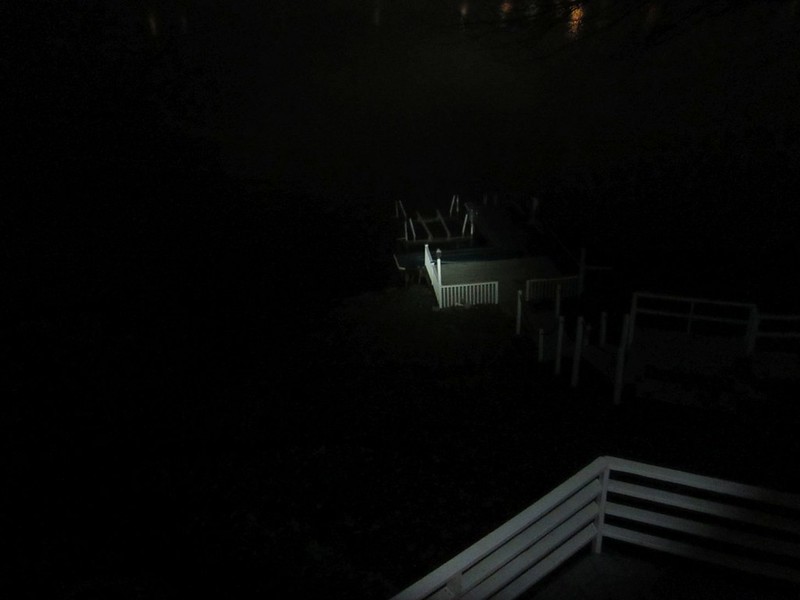
Med:

High:
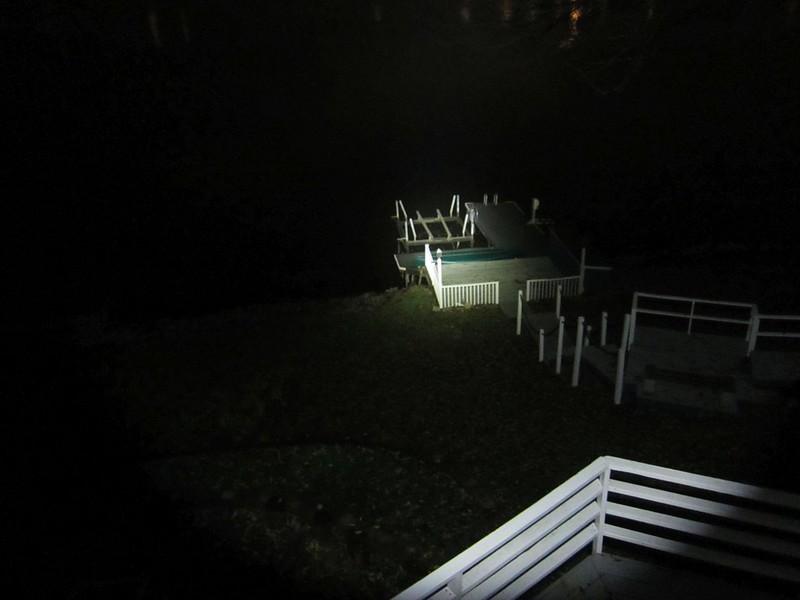
Turbo:

Interface
The interface is a simple and easy to learn.
From off:
All normal modes are memorized. Strobe is not memorized.
Problems
No problems were experienced with the TD26 flashlight while testing. At one point I thought the button was unresponsive; I then realized I was just pressing it too quickly. As noted above, it requires a certain cadence to change modes.
However, the included ThorFire BRC18650 battery did stop working for a while after one of the tests. It seemed that the protection circuit had tripped (as it read 0V), but I was unable to reset it using a Nitecore UM10 charger (which is capable of resetting tripped circuits). After about a week of sitting in a case, I tried once again and found the circuit was working and the cell at 3.6V. Between the low output performance, high internal resistance, and this unreliable result, I would not trust this cell. Hopefully the one I was provided is just a bad representation and others find better results.
Commentary
The ThorFire TD26 lives up to the advertised output specifications (at least when used with the right battery), and exceeded runtime specifications dramatically. Emitter tint is inoffensive. It is built tough and survived the various tests I threw at it including sitting at the bottom of a lake for a couple days. The interface is simple and easy to use. The battery tube has excellent grip and the button is easy to locate with gloves on. The lanyard attaches securely and stays looking good even in dirty water. 26650 battery compatibility means longer battery life than with 18650s. All of these are great selling points for the TD26.
Unfortunately, the action of the switch is a little tricky and inconsistent – and always leaves me wondering if it will change modes or not when I press it. Diving equipment needs to be predictable and reliable so this is a definite demerit. I also wish the battery springs had lower resistance or an inner/outer dual spring design to improve the current flow so that longer cells didn't have to be used to get optimal performance. The lowest mode, testing at 99 lumens, is also high.
Most users will find upgrading the battery to a high-drain, high capacity 26650 to be worth the investment.
Get acclimated to the switch's operation and upgrade the battery. Once that's done, the TD26 performs quite well so long as a sub 100 lumen mode isn't required.
Lux Meter: Dr. Meter LX1330B
Integrating "sphere": Homebuilt tube-style device calibrated on other known lights and test results. Numbers should be considered relative to each other and my other review figures but accuracy is in no way certified or guaranteed.
Camera: Canon SD4000IS
Multimeter: Craftsman 82170

Here are the key review details:

Skip to the commentary section at bottom to read my subjective notes on the TD26.
Disclaimer: This light was provided free of charge by ThorFire, shipping through the closest Amazon distribution center. As of November 5, 2017, the light can be purchased through Amazon (U.S.) for $45.99.
Unboxing
ThorFire uses the same packaging throughout most of their product line: A simple but sturdy cardboard box with white label. The TD26's label shows the TD26 light and included accessories. IT also lists the ThorFire website and contact information.

The TD26 is protected by bubble wrap and a sandwich of foam on top and bottom.

Spare o-rings, lanyard, manual, charger, and battery (inside the light) are included.

The included manual is in English only. It properly covers modes, features, operation, and troubleshooting.

ThorFire backs the TD26 with a 2 year warranty. Repair after 24 months is available for the cost of shipping and parts.
Design
The TD26 is a solidly built 26650-based light as required for its intended purpose: scuba diving. The light weighed 278 grams without battery– significantly more than other (non-dive-rated) single cell 26650 lights like the Olight R50 (158 g) or Acebeam EC60 (128 g). All parts of the TD26 are built thicker and stronger so it can survive water pressure at depths up to 100 m.
ThorFire's specifications report the TD26 to have 148 mm length, 50 mm width at head, and 35 mm width at the battery tube. My measurements were +/- 1 mm of those specs.
The size of TD26 is apparent when compared with other 26650 lights.
Left to Right: ThorFire S70S (2*26650), Utorch UT02, ThorFire TD26, Acebeam EC60, Olight R50 Pro.

Another comparison picture,
Left to Right: Olight M3XS-UT (18650*2), Utorch UT02 (26650), ThorFire TD26 (26650), Acebeam EC60 (26650), Olight R50 Pro (26650), Nitecore P16 TAC (18650), ThorFire TK15S (18650).

The TD26 with other ThorFire lights,
Left to Right: S70S (2*26650), TD26 (26650), TK15S (18650), TK15 (18650), VG-15S (18650), TG06S (AA).

Finally, here's the TD26 in hand. The wetsuit gloves are 3mm neoprene, size large.

The head of light has a thick, flat bezel and recessed lens. The depth helps protect the lens from damage. I did not attempt to remove the lens retaining ring but a thick gasket is visible between the lens and reflector.

The reflector is smooth and nearly imperfection-free; I found one small imperfection caused by dust but otherwise is clean and nice. The glass is AR-coated.

The XP-L emitter is perfectly centered. A small amount of excess solder is visible around the LED.

The head of the TD26 has the ThorFire logo and a scuba diver embossed in white. This is the only writing on the entire light. Edges are crisp and the printing has stood up well through my month of testing the light.

The side switch is a bare metal circle, raised and easy to locate by hand. Being a magnetic switch (common for dive lights), the feel is a bit artificial with no click or indent when pressed. There is also no rubber boot around the switch, so water can also get behind the switch button. This causes water to squirt out of the switch for a while after the light is out of the water (though to no detrimental effect).
The other thing I've noticed about the switch is that occasionally a very fast button press isn't registered. It takes a little bit of practice to get the feel for the timing since too short does nothing and too long turns the TD26 off.

The notches between the switch and the bezel provide a mild roll resistance.
Anodization is consistent and free of defects. It survived several drops indoors – and 2 days underwater – without any damage.
Rather than knurling, the light has raised ridges down the body tube of the light. These have alternating round and flat spots – and provides excellent gip. At the tail, these transition to a sizeable lanyard hole.

The included lanyard is thick – and a toothpick or other aid is required to feed the lanyard through the hole. As it attaches on the side, tailstanding is unaffected.

The lanyard itself has two spring-tensioned clips for cinching the lanyard on a wrist. Redundancy is key when diving; I'm glad to see ThorFire included two. The lanyard is also brown. At first, I thought this was a strange choice as most lanyards are black. But after using the TD26 in a freshwater lake, I think it was a very wise move by ThorFire. The lanyard looks the same after being in the dirty lake as it did before going in.

The TD26 disassembles into 2 sections – head and body tube. There is no separate tail cap. As expected for a dive light, the TD26 has two o-rings to prevent water ingression. ThorFire rates it to 100 meters underwater, IPX-8.
Threads are square cut and very well lubricated. They are also anodized, so a quarter turn of the tail will mechanically lock out the TD26.

The tail cap has a wide gold-colored spring.

The head has a smaller gold-colored spring, so both button top and flat top cells will work. Electronic reverse polarity protection and low-voltage shut-off means that unprotected cells can safely be used. Also notice how thick the wall of the head is!

The light includes a battery spacer so that narrower 18650 cells can be used in the 26650-width body. The inner diameter of the spacer is a couple mm too wide, so the cell can rattle a bit (though not affecting performance).

Performance
Beam
The smooth reflector produces a defined hotspot and corona with a weaker but still useful spill.

Tint
The bin is not specified by ThorFire, but I found the XP-L's tint to be very agreeable. The hotspot is neutral white, the corona is ever-so-slightly yellow, and the spill has a hint of cooler blue. Approximate temperatures were 4800K in the hotspot, 4300K in the corona, and 5700K in the spill.
To demonstrate the overall color balance, here is the TD26 surrounded by lights with emitters of various tints and temperatures.
L to R: Jetbeam C8R with cool XM-L2 T6, Convoy S2+ with cool XM-L U2 1B, ThorFire TD26 with XP-L, Astrolux S41S with neutral 219B, Lumintop Tool with warm 219B.

Output
ThorFire rates the TD26 at 1000 lumens on Turbo. 18650 or 26650 batteries can be used, but CR123As are not compatible per the manual.
The TD26 kit includes ThorFire's own 3000mAh BRC18650 cell. When I tested the cell in the TD26, it registered a disappointing 758 lumens on Turbo – well short of the 1000 expected. However, further tests identified the problem – and solution.
The included ThorFire 3000mAh 18650 had a three-test average internal resistance of 207mOhm using an Opus 3100 charger. For a brand-new cell, this is high. (It should be noted that the capacity did test north of 3000mAh, so the capacity rating is honest though the resistance is high.)
I then switched to an Acebeam ARC26650NP 5000mAh protected 26650 cell. Turbo output at 30 seconds registered a much higher 975 lumens – right in line with ThorFire's specifications. The 1000 lumen rating is accurate.
Since the Acebeam battery performed so much better, I then tested an unprotected Efest 4200mAh cell expecting to get even higher results. However, it generated only 887 lumens – quite strange.
Doing some more testing, I confirmed the reason – the protected cell's added length compressed the springs more, creating a shorter path for the current and thus higher output. Adding a small neodymium magnet to the Efest cell (to extend the length) added over 100 lumens!
Unfortunately, the ThorFire cell only saw a bump of less than 20 lumens on Turbo.
What's the takeaway? Skip the included ThorFire cell and use the longest high-drain cell you have for the best performance!
Back to the output tests… Using the Acebeam battery with ambient temperature of 78 degrees Fahrenheit, output was 989 lumens at turn-on and 975 lumens at 30 seconds.
Output was then a gentle curve down to 450 lumens at 2 hours and 28 minutes – when the light powered off. ThorFire reports a 45 minute runtime using a 5000mAh cell; this is significantly understated.

The TD26 dissipated heat very well. The light's external temperature didn't exceed 97F. As water dissipates heat better than air, heat should not be a concern with the TD26.
High is rated by ThorFire at 500 lumens. I measured 587 lumens at turn on and 578 at 30 seconds using the aforementioned Acebeam battery. Output dropped to 229 lumens at 4 hours and 35 minutes at which point the TD26 powered off. This 4:35 runtime exceeds ThorFire's 1:25 rating dramatically.

Medium is rated at 200 lumens. I measured it a bit higher at 295 lumens. Output once again dropped in a gentle curve, down to 97 lumens at 9 hours and 44 minutes when the TD26 powered off. ThorFire's 2:45 rating is 7 hours short of the light as tested!

Low is rated at 30 lumens per the manual but 100 lumens per the Amazon listing. I measured 99 lumens. Runtime was not tested.
While very low modes are not useful underwater in most situations, a lower mode would add versatility to the light when used on land. 99 lumens is quite high for the lowest mode.
All outputs as tested with various batteries:

All runtimes tested:

Water Resistance Tests
Since the TD26 is built for diving, I thought it prudent to run it through some stress tests.
First, I tied it to a rope, turned it on Medium, and threw it about 30 feet out into the water off my dock. The water depth is only around 2.5m – far short of the 100m the light is rated for, but I left it out there for over 48 hours.

After pulling it in, the TD26 worked without issue and was completely dry inside, as it should have been. Some mud caked into the cooling fins and anti-roll indentations reflect the time it spent on the bottom of the lake.

The second water resistance test is commonly called the "freezer test." First, the light is placed in a freezer (disassembled) until it reaches 0F (-17.7C). Then the light is assembled and quickly dropped into a bowl of hot water. As the temperature of the cold air inside the light rises, it builds pressure and tries to escape.
The TD26 also passed this test. None of the pressurized air escaped past the o-rings and out of the light. (The small bubbles are from the water, not the light. Notice no bubbles where the battery tube and head connect – the vulnerable point.)

Amperage Draw
As measured:
- Turbo: 2.3A
- High: 1.2A
- Med: 0.55A
- Low: 0.15A
Throw
With the included ThorFire battery, I tested throw distance at 1.46 meters and the resulting candela was 21,082 at 30 seconds - equivalent to 290 meters of throw. The Acebeam battery produced 28,990 Cd, good for 341 meters of throw.
ThorFire rates the TD26 at 350 meters of throw – which seems to be an honest rating. However, the manual lists Cd at 9800 – which would only be 198m of throw. 9800Cd appears to be a misprint.
PWM
Very high frequency PWM appears to be present on all modes. I was unable to see it visually in normal use or using the "mirror test." A camera's CMOS sensor did show the typical signs of high frequency PWM, though.
Parasitic Drain
The TD26 uses an electronic switch so some parasitic drain is normal. Only mechancial switches (which fully break the electrical circuit) escape having some parasitic drain. Dive lights generally use electronic (magnetic) switches so that one more point of ingress for water is eliminated.
The TD26 had a very low parasitic drain of only 41 μA. Using a 5000mAh 26650 cell, it would theoretically take almost 14 years to drain the cell. Thus, parasitic drain is of no concern with the TD26.
Mechanical lock out (thus breaking the circuit and reducing parasitic drain to 0) is possible by simply unscrewing the body tube a quarter turn.
Low Voltage Battery Protection
The battery's own low-voltage protection was not tripped on any tests. In fact, the TD26 has an abnormally high cut-off voltage between 3.3 and 3.4V. Runtimes would be longer (while still protecting the battery) if cut-off voltage was in the more common 2.8-3.0V range.
Included Charger
The included single cell ThorFire charger is designed to charge lithium-ion cells. It uses 1A, 5V micro-USB input to generate a max charge rate of 0.75A at 4.2V, per specifications. Connected to an inline USB meter, it detected power consumption of 0.76-0.83A – which is in line with ThorFire's specifications.
When no cell is present, or charging is complete, the single LED indicator on the charger is green.

When charging is in progress, the LED indicator is red.

Outdoor Beamshots
All photos taken with a Canon SD4000IS camera. 1/10" exposure, ISO1600, Daylight white balance, F2.0.
Approximate distances: White deck railing @ 15 ft., white fence in distance @ 75 ft., center of boat @ 100 ft.
Control shot:

Low:

Med:

High:

Turbo:

Interface
The interface is a simple and easy to learn.
From off:
- Short press the switch to turn the light on to the last mode used
- Short press the switch to cycle to a higher mode (L->M->H->T->L…)
- Double press to activate strobe
- o Short press to resume the last used normal mode
- Press and hold the switch for 1 second to turn off
All normal modes are memorized. Strobe is not memorized.
Problems
No problems were experienced with the TD26 flashlight while testing. At one point I thought the button was unresponsive; I then realized I was just pressing it too quickly. As noted above, it requires a certain cadence to change modes.
However, the included ThorFire BRC18650 battery did stop working for a while after one of the tests. It seemed that the protection circuit had tripped (as it read 0V), but I was unable to reset it using a Nitecore UM10 charger (which is capable of resetting tripped circuits). After about a week of sitting in a case, I tried once again and found the circuit was working and the cell at 3.6V. Between the low output performance, high internal resistance, and this unreliable result, I would not trust this cell. Hopefully the one I was provided is just a bad representation and others find better results.
Commentary
The ThorFire TD26 lives up to the advertised output specifications (at least when used with the right battery), and exceeded runtime specifications dramatically. Emitter tint is inoffensive. It is built tough and survived the various tests I threw at it including sitting at the bottom of a lake for a couple days. The interface is simple and easy to use. The battery tube has excellent grip and the button is easy to locate with gloves on. The lanyard attaches securely and stays looking good even in dirty water. 26650 battery compatibility means longer battery life than with 18650s. All of these are great selling points for the TD26.
Unfortunately, the action of the switch is a little tricky and inconsistent – and always leaves me wondering if it will change modes or not when I press it. Diving equipment needs to be predictable and reliable so this is a definite demerit. I also wish the battery springs had lower resistance or an inner/outer dual spring design to improve the current flow so that longer cells didn't have to be used to get optimal performance. The lowest mode, testing at 99 lumens, is also high.
Most users will find upgrading the battery to a high-drain, high capacity 26650 to be worth the investment.
Get acclimated to the switch's operation and upgrade the battery. Once that's done, the TD26 performs quite well so long as a sub 100 lumen mode isn't required.
Lux Meter: Dr. Meter LX1330B
Integrating "sphere": Homebuilt tube-style device calibrated on other known lights and test results. Numbers should be considered relative to each other and my other review figures but accuracy is in no way certified or guaranteed.
Camera: Canon SD4000IS
Multimeter: Craftsman 82170

